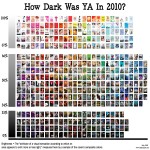 Welcome Back to YA Cafe, where book lovers can gather and chat about teen literature. I’m your barista, along with Ghenet from All About Them Words.
Welcome Back to YA Cafe, where book lovers can gather and chat about teen literature. I’m your barista, along with Ghenet from All About Them Words.
Each Friday we pick from a menu of topics and share our thoughts on our respective blogs. We’ve also got plans brewing for interviews, events and even some exciting giveaways, so stay tuned! Join the discussion by responding in the comments, on your own blogs or on twitter using the hash tag #YAcafe.
Today’s Special: Villains and Antagonists
First of all, let’s start off by clarifying the difference between a villain and an antagonist. A villain is the “bad guy” in the story, the character who’s responsible for bad things happening. An antagonist is a broader category so while all villains fall under the antagonist umbrella, not all antagonists are villains. The antagonist is the person or thing that gets in the way of the protagonist getting what he or she wants. Remember how every writing teacher under the sun says that the protagonist has to want something? Well, the antagonist is the thing that gets in the way.
The antagonist does not have to be human, it can be a whole society of people or even a natural or supernatural force. Your antagonist could be a natural disaster or the bully who lives down the street. Villains, however, are by definition human and they are characters in the story. So now that we’ve got that cleared up, how do we make our antagonists or villains the most evil and effective they can be?
3 Tips for a Super-Evil, Super-Awesome Antagonist or Villain
1) Give him/her/it a motivation. Oftentimes, writers take great pains to determine the motivation of their main characters, but the antagonist’s motivation falls by the wayside. The truth is, if the antagonist has a reason for doing what she’s doing, it makes her all the more real to the reader.
For instance, in The Hunger Games trilogy, the government of Panem is the antagonist and its motivation for creating these games is to maintain order in this shattered world. What makes this trilogy so intriguing is that the main character, Katniss (and the reader), never quite knows which side is the “good guys,” even at the very end. This technique of giving both sides of the conflict legitimate motivations is one of the things that keeps the reader hooked to the very last page.
2) Give him/her/it a soft side. Aside from the motivation, it also helps to give the antagonist a glimmer of goodness. Think of Darth Vader. Sure, he’s evil and wears that big helmet thing, but when it comes right down to it, he cares about his son and doesn’t want to kill him. The same is true in teen literature. Just think of any book with a “mean girl” character.
Sure, the writer can make that character mean and rotten to the core, but the story becomes all the more compelling if the mean girl has a soft side. Think of Massie and Claire in The Clique. At first, we want to root for Claire because she’s the underdog and the outsider and Massie is popular and mean. But as the story develops, we realize that Claire is not as nicey-nicey as she first appears and Massie is not pure evil. These contradictions are what keep the story interesting and keep the reader… well, reading.
3) Not all antagonists or villains need to be “well-rounded.” Sometimes, what the antagonist did is just so bad and the protagonist is in so much pain because of it that you don’t have to give the antagonist any motivation or a soft side. In fact, sometimes it’s just better if you let the antagonist be flat. A perfect example of this is Speak by Laurie Halse Anderson.
In this book, the antagonist has no good side, at least none that we can see. For most of the novel, he doesn’t even have a proper name with Melinda (the protagonist) calling him “IT” or “Beast.” In fact, he’s such a forgettable character that after reading the book, I hardly remembered anything about him. But that’s because the book is not about him as a character. It’s about the protagonist and the horrible thing he did to her. In that type of situation, you don’t need the antagonist to be “well-rounded.”
Take-home Message: In the end, the writer needs to decide whether the antagonist should be a fully fleshed-out character or not and this will depend on whether the antagonist needs to be sympathetic on some level or not. If the antagonist does not need to be at all sympathetic, then it’s OK to leave him or her flat to serve the story. On the other hand, if the writer does want the antagonist to be sympathetic, that’s when you have to give him or her a motivation and a soft side.
For more on Villains and Antagonists in YA, check out Ghenet’s post! And don’t forget the book club discussion coming up on October 28. The topic is pretty flexible, so go ahead and choose a book, then think about how the book you picked is scary to you. Then join the discussion on the 28th! (Just in time for Halloween… muhahaha!)






 Call me Gabi (pronounced gah-BEE). I'm a writer, freelance teacher, and a lover of books and words. I'm also the instigator of DIY MFA. iggi's my sidekick, but he thinks he's the brains behind this operation.
Call me Gabi (pronounced gah-BEE). I'm a writer, freelance teacher, and a lover of books and words. I'm also the instigator of DIY MFA. iggi's my sidekick, but he thinks he's the brains behind this operation.
 Goodbye is for Sissies
Goodbye is for Sissies YA Cafe: What YA Book are You Thankful For?
YA Cafe: What YA Book are You Thankful For? YA Cafe: Why I Love Dark YA
YA Cafe: Why I Love Dark YA YA Cafe: YA Appreciation Month
YA Cafe: YA Appreciation Month
Comments on this post
Thank you for putting this together. It feels so logical and yet, while I read through it, I realized I have a flaw with my villain! Off to tweak some scenes in my outline…
20. October - 4:07 pm